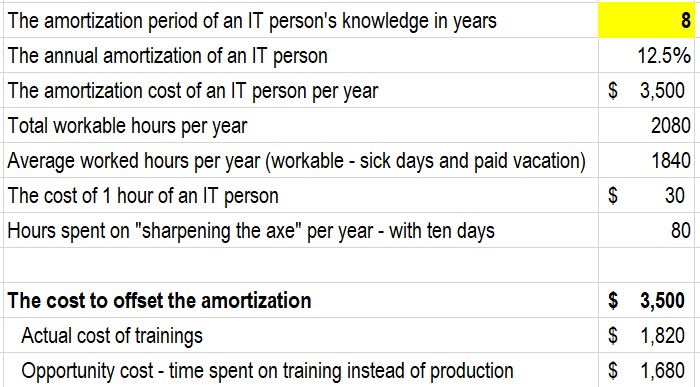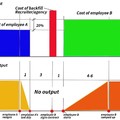
A couple of weeks ago I got in a discussion about training budgets. Not surprisingly the gentleman from finance thought it was too high, while I maintained a view that it was too low. His final argument was that we could not spend those dollars anyway since the business would not give us time for it. His reasoning stuck in my mind. Since the method suggested by Gary Larson (see above) may not work for everybody I figured I would prove my point by using an accounting analogy. So here we go.
I always had a strange feeling when someone called me (or anyone else for that matter) a “resource” since I would not even call my dog this way, but for my purpose this was the right term. For a minute let us treat humans working at a firm like robots, whose value is recorded in the books as fixed assets with a purchase cost and depreciated during a predefined number of years.
Most people acknowledge that the half-life of IT skills is finite: if one sits on his-her laurels over 8-10 years (ie. does not update his-her skills related to this profession) his-her knowledge would become outdated and the guy would slip down to a lower league with little hope to ever return. We need to sharpen the axe. The question is how much time and money should be spent on this sharpening and who should pay for it.
My next assumption was that sliding down to a lower league roughly halves one's cost to the employer. All guesstimates below are from Hungary, applying the local conditions. I inserted a link to the original model in the PS section if you want to play with it.
The linchpin of the argument is that the job market assesses your value correctly, ie. the gap between the two categories equals the money (including opportunity cost) someone needs to invest to stay in the current league. (Of course, the whole reasoning is valid only within the same country, since a fresh grad in an investment bank in NY earns twice as much as a senior guy in Eastern Europe working for the same bank.)
Let’s assume that the half-life of an IT person’s knowledge is 8 years. This comes to 3.5k USD “amortization” that we need to backfill annually. (This amortization is not linear and the boundaries between “leagues” are blurred, but I did not want to overcomplicate the model.)
Having talked with several folks on this topic we came to the conclusion that one needs roughly 10-12 days a year to stay afloat. So all in all we have 3.5k cost and opportunity cost and 80 hours to split between the two parties, the employee and the employer. (a friend of mine from Berlin mentioned that the state can have a word in this thing, but this is the distant future for CEE so we ignore it for now.)
With 2080 workable hours and 88% “billable” utilization an hour of a skilled IT person will cost to the employer around 30 USD, so this is the money “lost” if this person is not working, but learning.
We arrived at the crucial point of this post, the split of time and money spent on training. I assumed that an average IT person would be willing to spend 1% of her-his annual net income on learning (roughly the annual subscription to O’Reilly or Coursera Plus) and also figured that people are more sensitive to spending money than scarifying their free time. (if IT is your passion, you will happily spend way more on it than 24 hours a year.)
So here is the model that I ended up with:
Having played with it for a while I arrived at 1.4k USD as a reasonable amount of training budget per head per year. In a COVID era this might be lower, but certainly not below 1k USD.
As usual answering a question (regardless how good this answer is) raises new questions:
- Should this money be spent evenly on the entire staff or should there be a bias towards high performers or potential high flyers? (my assumption is yes.)
- How shall we measure the effectiveness of training? People tend to freak out from certification. (and indeed, some certs are overpriced and lack real life applicability.)
- How shall we measure the actual impact of training on the bottom line of the firm? If you cannot measure it, the whole argument becomes weaker.
- Should we apply different split ratios for different subjects? (eg. English vs. hard core technical skills) My bet is that language skills should be treated as a prerequisite to actual learning, therefore the employee’s problem.
As always, I will be glad to receive feedback on this post.
PS: A la recherche du temps perdu – the link to the model.








